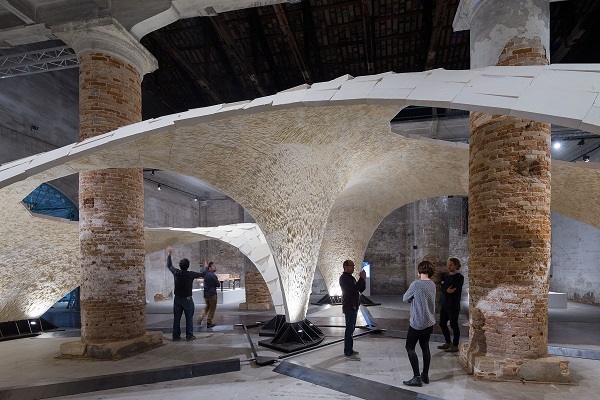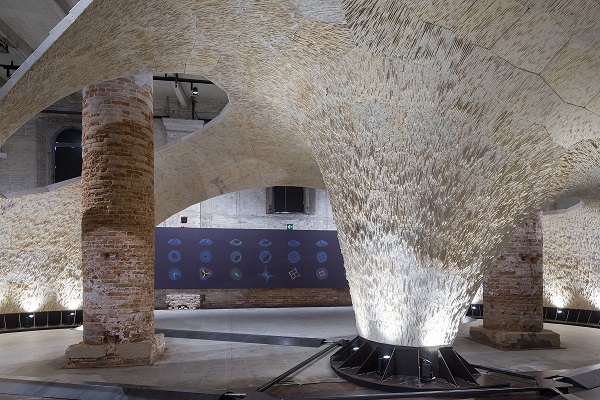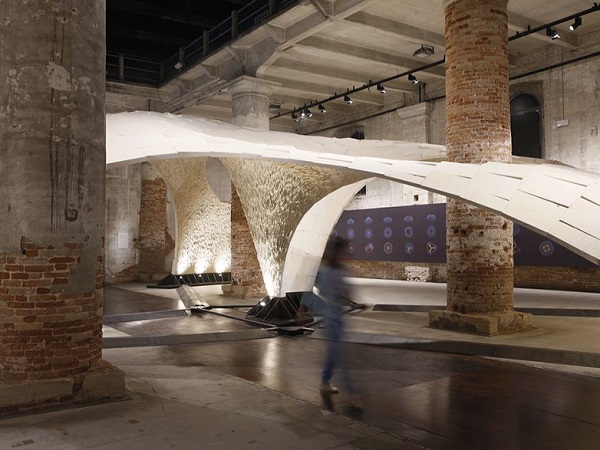Beyond bending - The Armadillo Vault
Throughout June 2016, the 'Beyond Bending' installation is being showcased at the15th International Architecture Exhibition in Venice. The installation demonstrates the Armadillo Vault, an innovative limestone canopy that uses no adhesive and has been called a "milestone for stone engineering".
Inspired by historical design and construction methods, ETH Zurich’s Block Research Group, led by Prof. Dr. Philippe Block and Dr. Tom Van Mele, renew the knowledge of the past using present-day technologies to discover elegant new structural forms.
Beyond Bending is a collaborative effort with the engineering firm Ochsendorf, DeJong & Block (ODB) and The Escobedo Group, and aims to offer answers to the question, 'What can we regain from the past, and how can we reshape or innovate upon that knowledge to fit present and future needs?'
The exhibition’s various elements – four prototypes of vaulted floor systems, a series of graphical force diagrams, and an expansive stone vault – demonstrate that, by better understanding the flow of compressive forces in three dimensions, excess steel can be eliminated, natural resources can be conserved, and materials like earth and stone can be reimagined for the future.
The exhibition’s centrepiece, the Armadillo Vault, embodies compression made possible through geometry. Its shape comes from the same structural and constructional principles as historic stone cathedrals, enhanced and extended by computation and digital fabrication.
Comprised of 399 individually-cut stones, unreinforced and without mortar, the vault spans 16 m with a minimum thickness of only 5 cm. The tension ties balance the form, and funicular geometry allows the vault to stand in pure compression.
The sophisticated form of the Armadillo Vault emerged from computational graphic-statics based design and optimisation methods developed by the Block Research Group. The engineering of the geometrically discrete shell, done by ODB Engineering, also used innovative computational approaches to assess stability.
Each stone is informed by structural logic, by the need for precise fabrication and assembly, by the hard constraints of a historically protected setting in the Biennale’s Corderie dell'Arsenale, as well as by tight limitations on time, budget, and construction. To simplify the fabrication process and avoid the need to flip the stones during cutting, the limestone wedges are planar and smooth on the exterior. Their interior sides are marked by a series of grooves resulting from initial rough cutting. Rather than mill these surfaces away, they remain as an expressive feature, aligned with purpose to serve as visual reminders of the force flow.
After its initial fabrication and assembly by The Escobedo Group in Texas, the vault was carefully measured and marked, disassembled and shipped to Venice, where the same team of master stonemasons reassembled it on site in just over two weeks. Like an intricate 3D puzzle, it could be deconstructed and built again at future locations.
This unique project grows out of a foundation of trust and experience gained individually and collectively and is the culmination of many years of research in all aspects of stone structures by the team members.
Content and images courtesy of ETH Zurich.
“Beyond Bending”
Main exhibition, Corderie dell’Arsenale – Block Research Group
15th International Architecture Exhibition in Venice
[edit] Related articles on Designing Buildings
Featured articles and news
Latest Build UK Building Safety Regime explainer published
Key elements in one short, now updated document.
UKGBC launch the UK Climate Resilience Roadmap
First guidance of its kind on direct climate impacts for the built environment and how it can adapt.
CLC Health, Safety and Wellbeing Strategy 2025
Launched by the Minister for Industry to look at fatalities on site, improving mental health and other issues.
One of the most impressive Victorian architects. Book review.
Common Assessment Standard now with building safety
New CAS update now includes mandatory building safety questions.
RTPI leader to become new CIOB Chief Executive Officer
Dr Victoria Hills MRTPI, FICE to take over after Caroline Gumble’s departure.
Social and affordable housing, a long term plan for delivery
The “Delivering a Decade of Renewal for Social and Affordable Housing” strategy sets out future path.
A change to adoptive architecture
Effects of global weather warming on architectural detailing, material choice and human interaction.
The proposed publicly owned and backed subsidiary of Homes England, to facilitate new homes.
How big is the problem and what can we do to mitigate the effects?
Overheating guidance and tools for building designers
A number of cool guides to help with the heat.
The UK's Modern Industrial Strategy: A 10 year plan
Previous consultation criticism, current key elements and general support with some persisting reservations.
Building Safety Regulator reforms
New roles, new staff and a new fast track service pave the way for a single construction regulator.
Architectural Technologist CPDs and Communications
CIAT CPD… and how you can do it!
Cooling centres and cool spaces
Managing extreme heat in cities by directing the public to places for heat stress relief and water sources.
Winter gardens: A brief history and warm variations
Extending the season with glass in different forms and terms.
Restoring Great Yarmouth's Winter Gardens
Transforming one of the least sustainable constructions imaginable.

























